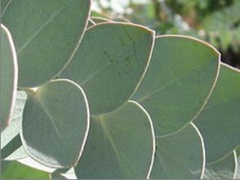Eucalyptus, Silver dollar tree
| Infobox on Eucalyptus, Silver dollar tree | |
|---|---|
| Example of Eucalyptus, Silver dollar tree |  |
| Facts | |
| Origin | - |
| Stowage factor (in m3/t) | - |
| Humidity / moisture | - |
| Ventilation | - |
| Risk factors | See text |
Eucalyptus, Silver dollar tree
Contents
Description / Shipment / Storage / Risk factors
Scientific Name and Introduction
Eucalyptus spp. The silvery-green leaves of the juvenile form of Eucalyptus pulverulenta are a very popular foliage item, used in fresh and dried form. A number of other species of Eucalyptus also are used as cut foliage. Eucalyptus is Greek for well and lid, referring to the sepals and petals, which are united to form a cap that is shed when the flower opens, revealing the showy coloured stamens.
Quality Characteristics and Criteria
As with other foliage, Eucalyptus performs better in the vase if leaves are mature. Branches are harvested to provide long stems, but leaving growing points behind for development of new branches. Stem tips should not be wilted when purchased.
Grading and Bunching
Quality foliage is bright blue-green in colour, has undamaged leaves, and is uniform in length. Eucalyptus branches are sold in grower bunches by weight, usually as 454 g (1 lb) bunches.
Ethylene Sensitivity
Eucalyptus branches are not sensitive to ethylene, but if the foliage is poorly handled, is warm, and water-stressed, it can produce concentrations of ethylene that could damage ethylene-sensitive flowers that have not been treated with 1-MCP or STS.
Pretreatments
No pretreatments are required.
Storage Conditions
Eucalyptus foliage should be stored at 0°C to 1ºC.
Packing
Eucalyptus is normally packed in horizontal fibreboard boxes without additional packing materials.
Special Considerations: Handle this species with gloves to prevent hands from becoming sticky. Eucalyptus are native to areas like Australia and Tasmania but over 200 species have been introduced elsewhere. As a result, this species predominates in certain woodlands in California. Many florists believe eucalyptus gives off a lot of ethylene because of its strong fragrance. In fact, most species and cultivars do not produce excessive amounts of ethylene gas, although some will produce potentially detrimental quantities of ethylene if they become water stressed. Hence, make sure this species is properly hydrated. Eucalyptus can be treated with various coloured glycerin-based solutions, which result in preserved specimens. Australian and Israeli researchers are investigating the possible use of Eucalyptus as flowering branches, and it is expected to see this interesting item increasing in the trade in the future.
Special Considerations
Handle this species with gloves to prevent hands from becoming sticky. Eucalyptus are native to areas like Australia and Tasmania but over 200 species have been introduced elsewhere. As a result, this species predominates in certain woodlands in California. Many florists believe eucalyptus gives off a lot of ethylene because of its strong fragrance. In fact, most species and cultivars do not produce excessive amounts of ethylene gas, although some will produce potentially detrimental quantities of ethylene if they become water stressed. Hence, make sure this species is properly hydrated. Eucalyptus can be treated with various coloured glycerin-based solutions, which result in preserved specimens. Australian and Israeli researchers are investigating the possible use of Eucalyptus as flowering branches, and it is expected to see this interesting item increasing in the trade in the future.
Sources used
BMT Consolidated Manual on (Dutch) Flower Bulbs, cut flowers/greens and potted plants.











